Every Indian city has at least one man-made mountain where ‘waste’ generated in our homes and businesses end up. About 90% of the staggering 150,000 metric ton of urban solid wastes generated everyday make their way to such locations. Called dump yards, landfills or garbage mountains, these toxic sites are the dark underbelly of India’s bustling, glittering cities and are home and workplace for tens of thousands of people.
Swacch Bharat Mission-Urban’s 2021-22 budget of INR 1,41,678 crore indicates India’s desire for cleaner cities. The budget encourages garbage free cities but makes no specific provision to improve conditions for disadvantaged communities near landfills.
In this blog we put together a picture of the harsh environment endured by communities living in the shadow of garbage mountains in six metropolitan cities in India. Using Google Earth images, past and recent news reports, and research papers we trace changes on these sites and their corresponding settlements.
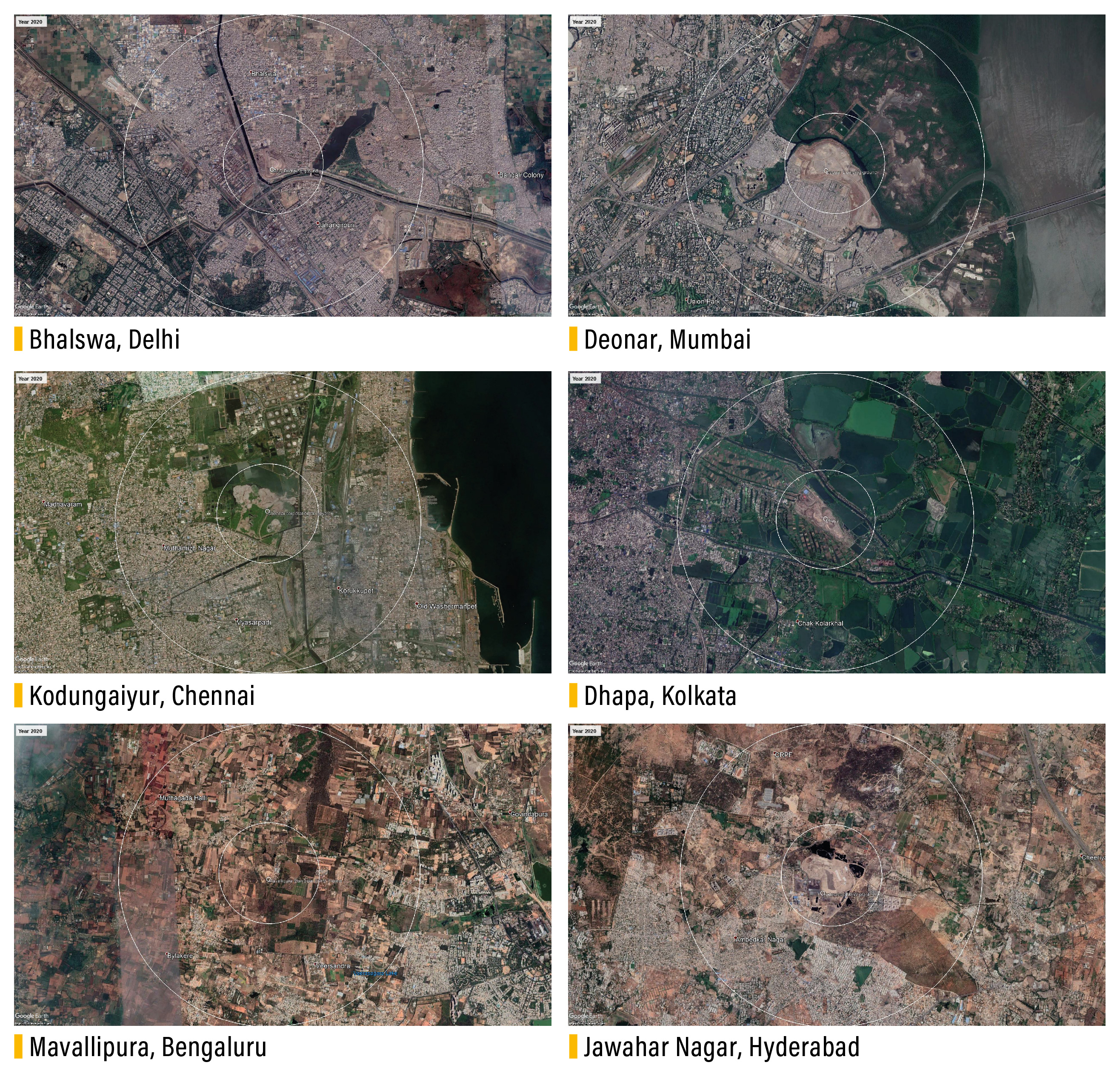
Most dumpsites are two to three decades old and currently receive 2,000 (Bhalswa) to 9,000 (Deonar) metric ton of solid waste daily. Only a few areas on large landfills have new and advanced solid waste management technology (like waste-to-energy, composting and refuse-derived fuel systems). Legacy dumps remain problematic as the decomposition of decades old mixed waste causes extreme water and air pollution.
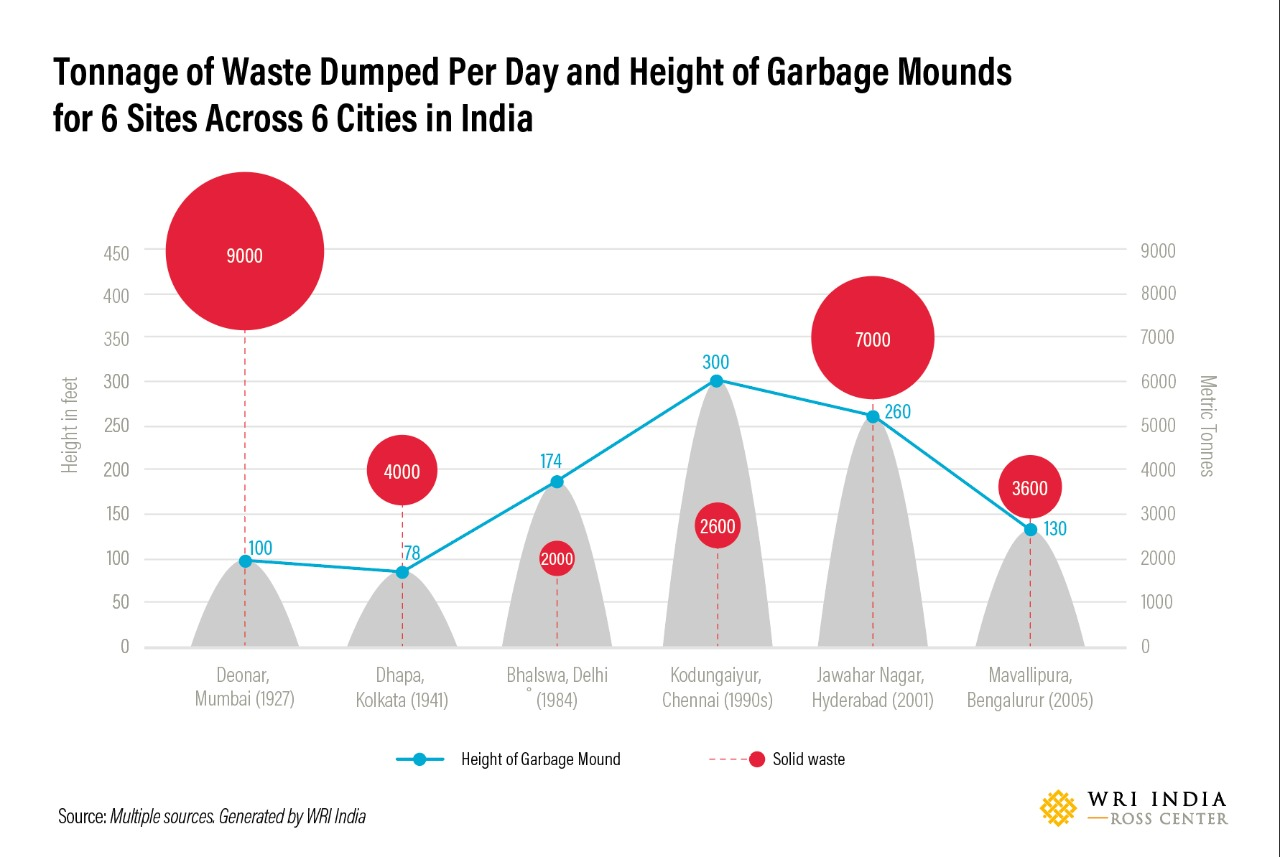
Google Earth images (2000, 2010, 2020) show increasingly dense settlements around these six landfill sites. Who inhabits the foothills of these garbage mountains, living perilously close to toxic fumes and poisoned waters? How did they come to live in these harsh conditions and why do they not leave?
Read more: Nearly a third of Kodungaiyur residents have difficulty breathing, but no action on waste dump
Who lives closest to the landfills?
These locations were once distant suburbs of cities, but today settlements crowd around these landfills. Pungent smells, frequent fires and polluted groundwaters make these unhealthy locations and the people who live here are waste pickers and daily wage earners earning too little to ever leave these precarious shelters.
The Bhalswa landfill in northwest Delhi towers 53 meters over the Bhalswa Resettlement Colony, Bhalswa Dairy and Shraddhanand Colony. The Resettlement Colony houses communities that were relocated here under a state resettlement program in 2000-01.
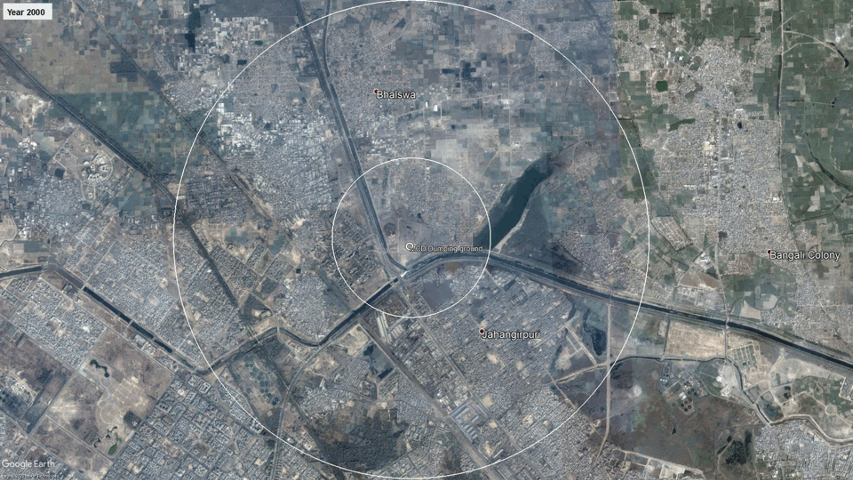
The landfill in Kodungaiyur, Chennai has Slum Board tenements nearby where relocated pavement dwellers and slum households reside. Jawahar Nagar, Hyderabad has housing for the urban poor built under the Rajiv Gruhakalpa initiative at the base of the garbage mountain and a further 32 non-notified slums sheltering about 71,000 people are nearby.
In Mumbai the poor converge in the 256 slums and 13 resettlement colonies in Chembur East, Govandi, Mankhurd and Shivaji Nagar near Deonar (Mumbai East Ward population is 6 lakh) where some of the cheapest housing in the city is available. In Dhapa, Kolkata the urban poor from across the city are relocated here and the dwellers’ limited resources do not allow them the option of moving to cleaner, healthier environs.
In Bengaluru, the landfill site at Mavallipura (now closed) is away from dense urban settlements, but nearby rural communities suffer as the landfill continues to pollute local groundwater.
In city after city, we read of the poor and impoverished forced to live closest to garbage dumps because they cannot afford housing elsewhere or local governments have resettled them on these polluted lands which no one covets. What are the impacts on these neglected communities, of our fellow citizens, who we have relegated to these toxic urban environments?
Working and living amidst poisoned waters and toxic air
Delhi’s Bhalswa dump yard has halved the iconic Bhalswa lake to 84 acres and contaminated the lake and surrounding groundwater. Deonar, Mumbai’s garbage mountain contaminates creeks and mangroves to its north and east, eventually polluting Thane Creek. Dhapa, Kolkata sits amidst the east Kolkata wetlands leaching pollutants into the ecosystem which supplies much of the city’s vegetables and fish. In Jawahar Nagar, Hyderabad the Malkaram Cheruvu, an erstwhile irrigation tank is now a toxic leachate pond.
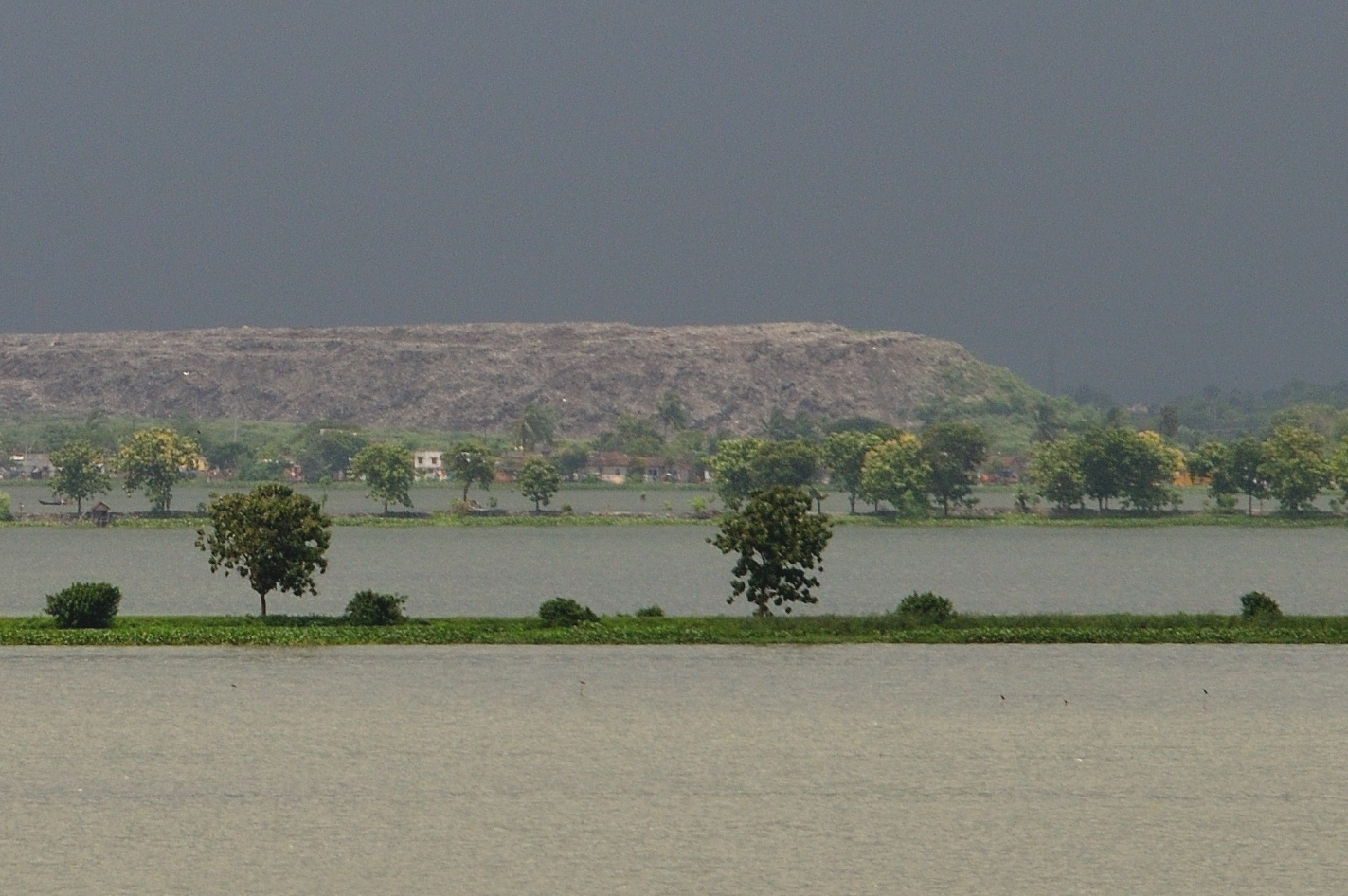
Groundwater sampling in these locations indicate high levels of toxic contaminants rendering the water highly dangerous to use. Inadequate supply of clean water, high costs of bottled water and lack of sanitation force households here to use the groundwater causing severe health issues. Poor health and higher disease incidence is closely linked to inadequate service provision. Across these six cities, people near these sites suffer from chronic and acute health issues, with high incidence of tuberculosis, asthma and gastrointestinal disorders. Residents life spans are shortened, people in Dhapa barely live till 50 and average lifespan in Deonar is a mere 39 years.
Read more: People in this Mumbai slum barely make it to 40; here’s why
The livelihoods of residents here are also inextricably intertwined with these toxic landfills. Many, including young children, work as waste pickers collecting recyclable material. They breathe toxic air, risk fire and explosion exposure and are injured or killed when unstable parts of such man-made mountains collapse.
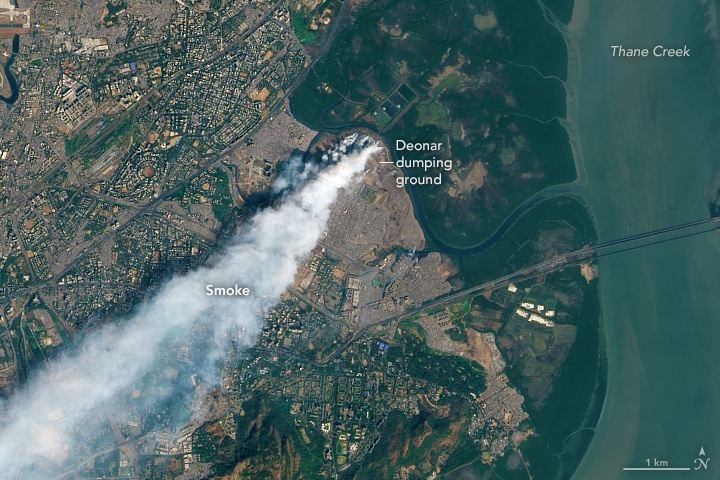
Government authorities would earlier evict residents and demolish settlements near dump sites but the core issues of unplanned and unregulated urban development, the lack of serviced affordable urban housing for all, lack of safe livelihood options and improper solid waste management remain unresolved. Today the benign neglect of authorities leads to fewer public spaces, low-quality and unsafe housing, inadequate water supply, sanitation and waste management services in these communities.
These disenfranchised communities cannot easily access support of elected officials and city managers and limited financial resources disable them from pursuing solutions independently. Communities bordering polluted landfills and dump yards remain locked into intergenerational poverty cycles while the rest of the city continues to thrive.
Equalizing our unequal cities
India is a signatory to the Sustainable Development Goals (SDGs) and Goal 11 commits to making cities and human settlements inclusive, safe, resilient and sustainable. At the core of the SDGs is the principle of “leaving no one behind”. But how can India’s cities be reformed on the tenets of SDGs when we have consigned vast swathes of the urban poor, young and vulnerable to live and work in toxic and hazardous dump sites.
Communities near landfills face complex challenges and a multi-pronged approach is required to address these issues. Urban authorities must simultaneously improve service provision to existing communities and provide livelihood opportunities so that people need not work in unsafe conditions.
Initiatives such as the Jal Jivan Mission-Urban, Swacch Bharat Mission-Urban whose objectives include universal coverage of water supply and sanitation and waste management offer hope if they prioritize actions in vulnerable communities living near landfills and implement holistic and integrated solutions. The emerging ‘new waste economy’ focused on circular practices and resource recovery offers livelihood and entrepreneurial opportunities, if waste sector workers are formally integrated into waste management services, as in the case of Ahmedabad, Bengaluru and Pune.
Finally, urban solid waste management must be reimagined to eliminate such toxic garbage mountains in the future and existing sites must be remediated. Indian cities from Bengaluru to Alappuzha are slowly shifting to decentralized solid waste management approaches with household and community level waste segregation and resource recovery solutions being implemented successfully.
Such ambitious multi-pronged approaches are too large and complex for any single entity (whether government, private or community) to manage and require new partnerships to be successful. If we want truly equal cities a multitude of stakeholders, including government agencies, civil society organizations and local communities, must collaborate to urgently improve habitations and livelihoods for those in proximity to garbage mountains.
[The original version of this article appeared on the blog of WRI India Ross Center on May 27, 2021. Views expressed here are the authors’ own.]